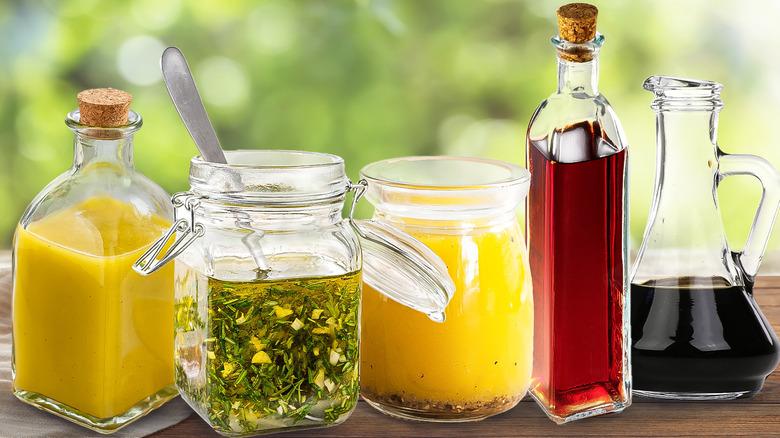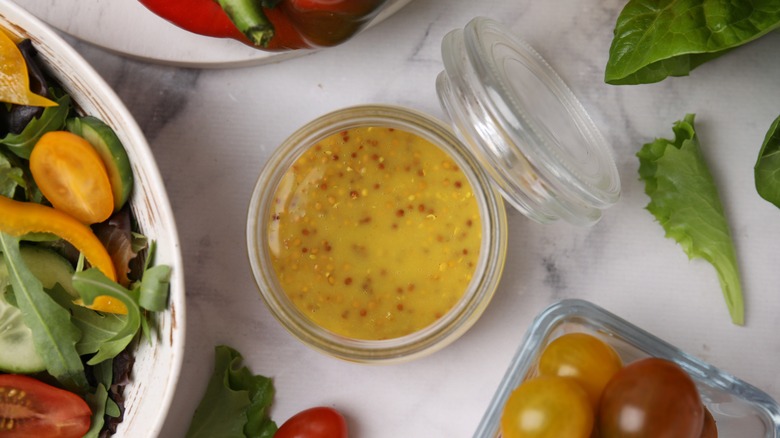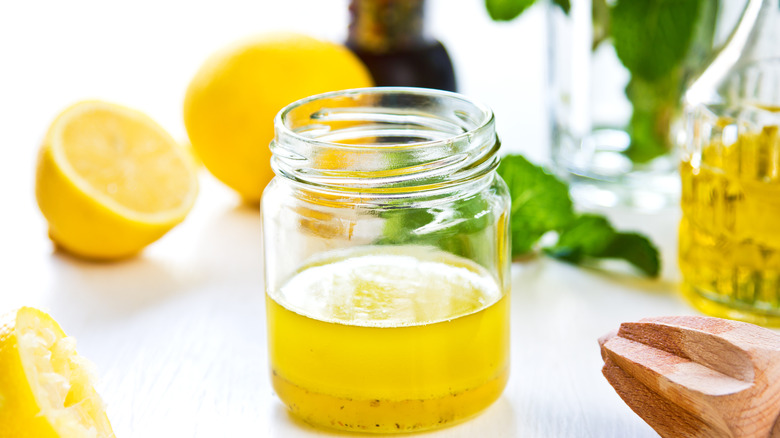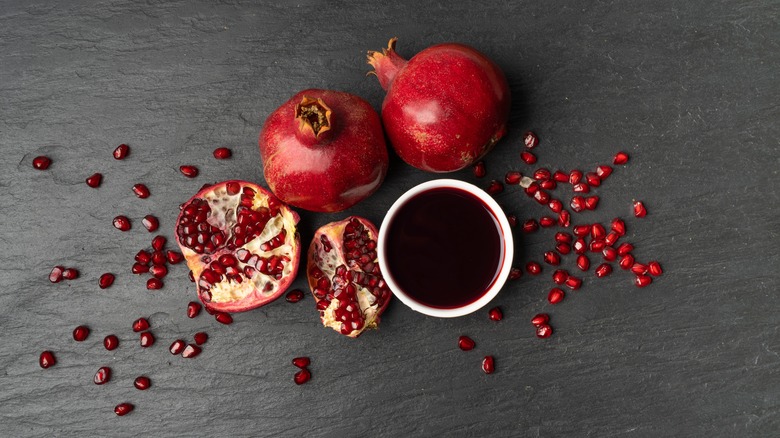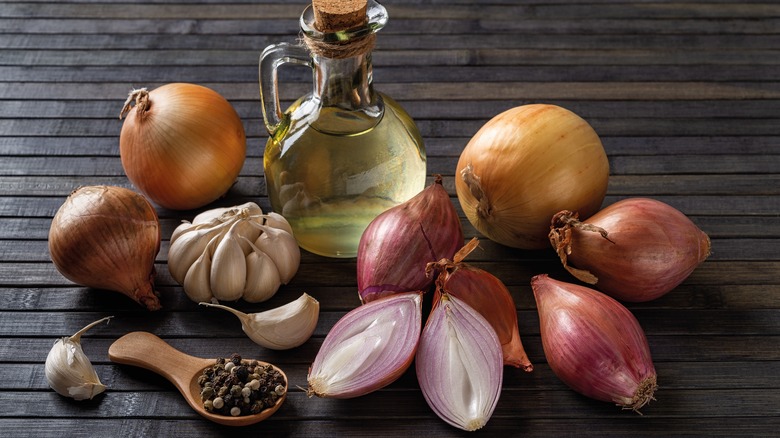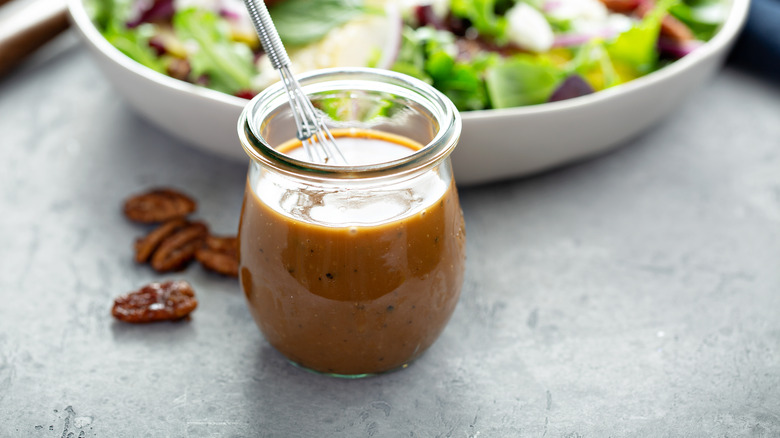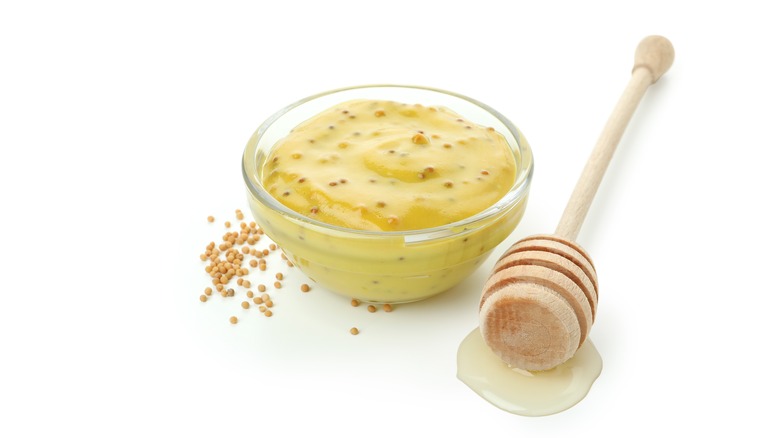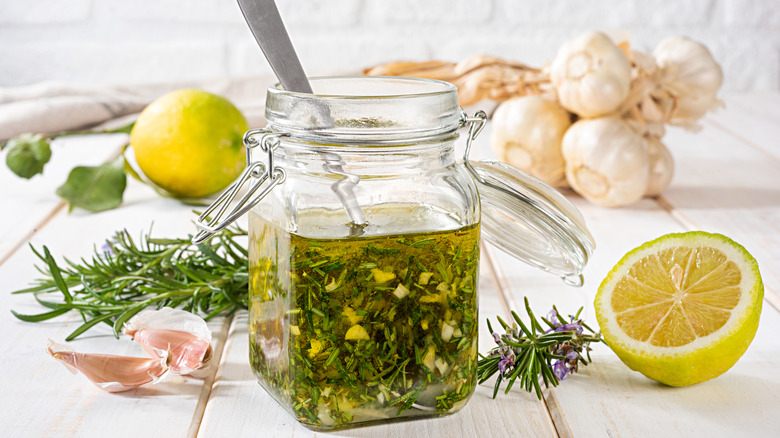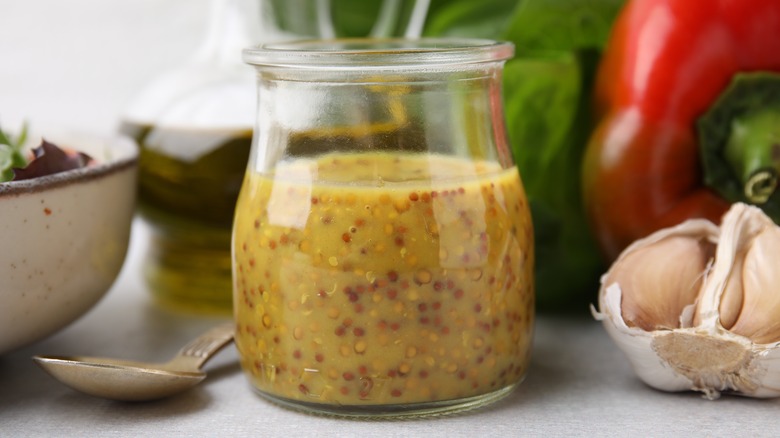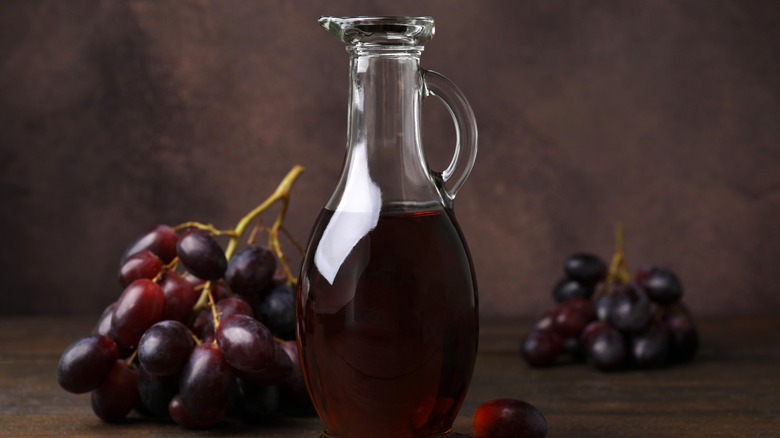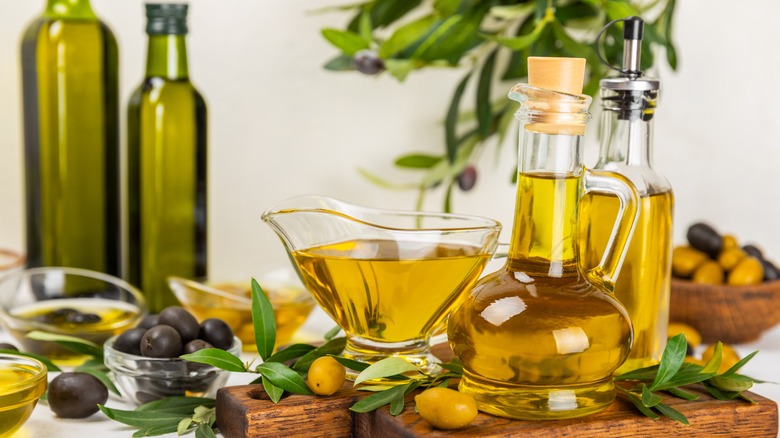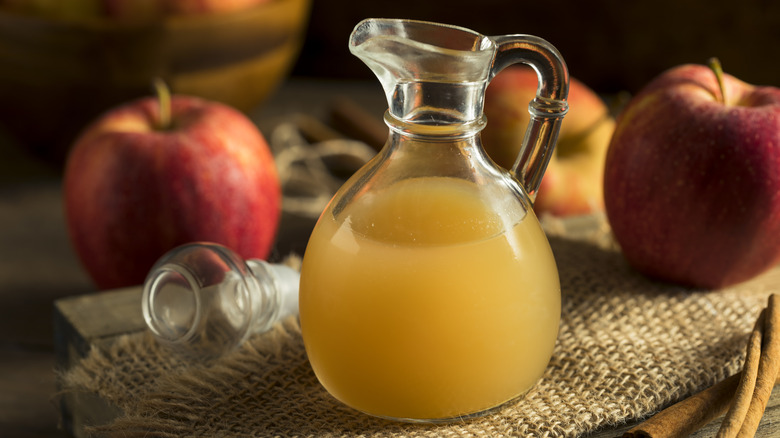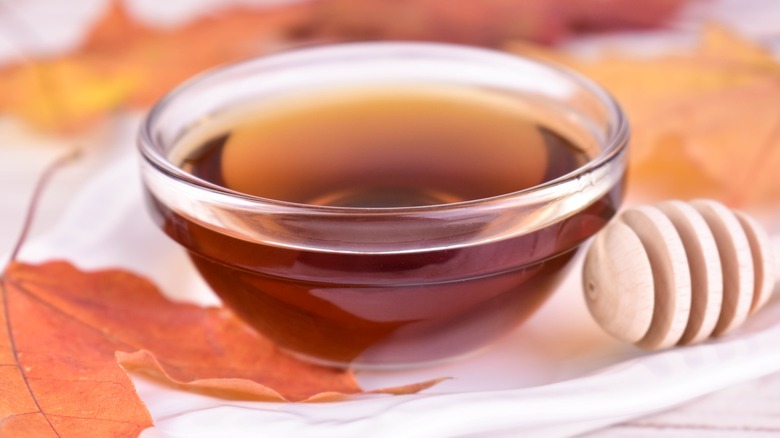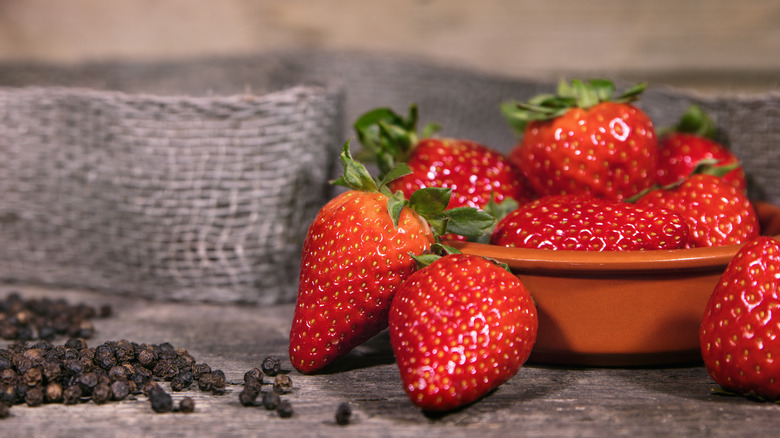14 Types Of Vinaigrettes, Explained
While incorporating more salads into your diet is fine in theory, sometimes putting it into practice can feel a bit, well, boring. If you've been feeling less than inspired by your veggies recently, you are likely in need of a good homemade vinaigrette to jazz things up. Vinaigrettes are generally made from oil, some sort of vinegar, and a couple of additions, and they have the magical capability of elevating a dish.
You may be wondering why you would bother making your own vinaigrette when there are plenty of store-bought options available. First of all, it takes virtually no effort at all to make most vinaigrettes, as you are about to find out; a couple of minutes is all it takes to whip one up. More importantly, store-bought dressings are frequently filled with sugar, artificial flavorings, and many ingredients you can't pronounce, so making your own is a much more sensible option that will also save you money. So grab your olive oil — extra-virgin, of course — and let's explore the world of vinaigrettes.
Classic vinaigrette
Let's start with the simplest option, as getting a classic vinaigrette right is the key to creating a variety of more adventurous ones. If you are used to shop-bought vinaigrette, you will be surprised at how easily you can whip up a homemade one, and you will never reach for a bottle of dressing at the store again.
You must not underestimate the importance of the oil you use when making a homemade vinaigrette. Extra-virgin olive oil is top of the list if you have it, otherwise choose another unrefined oil. Next, choose a vinegar. White wine vinegar is a good all-rounder that will match most salads with its fairly neutral flavor. Mix the oil with the vinegar in a ratio of 3:1, whisking well to incorporate them.
Most vinaigrettes have a touch of mustard to add some tang, so add a teaspoon of Dijon or wholegrain for a smooth flavor that's not too hot. Mix well again to create a balanced dressing. Feel free to stop there as your vinaigrette will already be delicious, or add some minced garlic for an added punch.
This classic vinaigrette can be tossed with a green salad to give it some pizzazz or drizzled over roasted vegetables before serving. Once you've mastered this basic version, it's time to get creative with some exciting additions.
Lemon vinaigrette
If you love a classic vinaigrette but are looking to zing things up a bit, give this lemon and herb version a try. The key ingredient in this dressing is obviously the lemon juice, so make sure it is as fresh as possible. If at all possible, squeeze it straight from a lemon at the time you make the vinaigrette, as bottled lemon juice just doesn't measure up. Rolling the fruit firmly on your cutting board for a few seconds before cutting it open will allow you to get more juice from the lemon, giving your dressing even more zing.
Mixing up the vinaigrette is easy — olive oil, vinegar, mustard, and lemon juice are all whisked together to create a thick liquid. If you're worried about the dressing being too sharp, you can add maple syrup or honey, but just add a little at a time to make sure you don't ruin the balance of the vinaigrette.
The fresh herbs you use are up to you, but thyme and parsley will both work well with the citrus flavors. Season with a touch of salt and a twist of black pepper. This citrus-based vinaigrette goes brilliantly with any entree that incorporates lemon, such as lemon chicken or a seafood platter.
Pomegranate vinaigrette
For a fruity dressing that is sweet as well as tangy, consider making yourself some delicious pomegranate vinaigrette. Pomegranates are fantastic underused berries that make a great addition to any salad, adding a delightful burst of flavor and crunch when you bite into them. While you can make this vinaigrette with store-bought pomegranate juice, making your own from the seeds will give a much fresher flavor.
Pomegranates are packed with antioxidants which are crucial for brain and heart health, and buying a fresh pomegranate to make this vinaigrette means you will get more of them than from a carton of juice. Pomegranates are in season in winter, so if you're making this dressing in the colder months, grab yourself a whole pomegranate, juice what you need, and add the remaining seeds to your salads for the rest of the week.
To make the pomegranate vinaigrette with fresh seeds, add olive oil, vinegar, Dijon mustard and a squeeze of lemon juice into the blender along with the seeds. You can add honey or maple syrup to make the dressing a bit sweeter or leave them out to keep it sharp and tangy. Whizz all the ingredients up then season to taste. The vinaigrette will taste great on any salad but goes particularly well with this delicious winter Greek salad.
Shallot vinaigrette
To create a tasty vinaigrette that works well with roasted vegetables as well as salad, try making a shallot vinaigrette. Shallots are alliums — the same family as onions and garlic — and their flavor is often described as a mix of the two. They are sweeter than regular onions but can generally be used interchangeably with them.
To make the perfect vinaigrette, dicing the shallots finely is the key. Cut the shallot in half to make sure you have a stable surface to cut it on, then slice lengthways to create thin strips. Keep the strips together, turn them round, then slice thinly across in the opposite direction to make tiny cubes that will be fine enough to flavor the dressing without any large chunks to overpower it.
Add the finely diced shallots to a couple of tablespoons of vinegar and around twice as much olive oil. A little Dijon mustard and honey can be added to balance the flavor with both spicy and sweet notes, before mixing everything together and seasoning with salt and black pepper.
Toss the vinaigrette with a green salad as its robust flavor will match the strength of the peppery greens, or drizzle over roasted vegetables before serving. The sharp notes will add a punch to the sweet, caramelized veggies to create a mouthwatering side dish.
Balsamic vinaigrette
No matter what savory dish you're making, there is virtually always room for a balsamic vinaigrette. The first step in creating a top-notch balsamic vinaigrette is selecting high-quality vinegar. The Italians take their balsamic very seriously, so there will be plenty to choose from in your local store. For the best vinaigrette, choose an aged balsamic that will be rich and syrupy, and ideally one that says 'Aceto Balsamico Tradizionale' on the label, which shows it has been created in the classic Italian way.
To prepare your vinaigrette, add three parts olive oil to one part balsamic. If you have gone to the trouble of sourcing top-notch vinegar, be sure to match it with extra-virgin olive oil. The thick nature of both liquids means you will end up with fantastically viscous nectar at the end. Whisk the two liquids well, then add a touch of Dijon mustard for a little kick.
There's a good chance you won't want to sweeten your vinaigrette, but you can always add honey to balance out the sharper ingredients. Seasoning can take the form of salt and pepper or herbs such as basil or oregano. Tomatoes and balsamic were made for each other, so slather your dressing over them whenever you get a chance — Caprese salad is the perfect dish for this vinaigrette.
Honey vinaigrette
If a sweeter-than-usual vinaigrette is what you need, try adding honey to your usual dressing. The addition of luscious honey will match the sharpness of the vinegar perfectly to create a balanced vinaigrette with beautiful sweet notes.
Though you may assume that adding honey to your dressing would make it less healthy, if you choose the right type, you can also enjoy a number of health benefits. Choose raw or minimally processed if you can — the darker the color, the better. It will cost more in the short term, but the nutrients it contains will make it worth the extra expense. Plus, if stored correctly, honey will never expire, so you can use it for years to come!
To make your honey vinaigrette, combine two tablespoons of balsamic vinegar with four tablespoons olive oil, then add two tablespoons of honey. Whisk it thoroughly to create a homogenous liquid. Taste, then season with salt and pepper as needed. This dressing works wonderfully with any dish that contains blue cheese or goat cheese, or fruit of any kind. It will match this delicious butternut squash salad perfectly. You can also baste vegetables in it before roasting to help bring out the sweetness as they caramelize or drizzle it on top of a fruit salad to create a little tang to balance the sweet fruit.
Herb vinaigrette
The key to this vinaigrette is to really go for it with the herbs. A restrained dressing with a touch of basil is not what we're aiming for — this vinaigrette needs to have bold, punchy flavors that elevate the dishes it is drizzled on. Choose a few different herbs and add generous quantities of each into the dressing.
Parsley and basil go with just about all other herbs, so include them both in your mix. The other herbs you add may depend on what you are serving the vinaigrette with. If you are planning a fish dish, dill will work well. Its aniseed notes complement oily fish such as salmon, as well as shellfish nicely. If your dish has a Mediterranean flavor profile, add fresh oregano to your vinaigrette for a light and summery taste.
Whatever herbs you opt for, grab a good handful, chop them finely and add to a mixture of three parts extra virgin olive oil to one part vinegar. Whisk everything together then taste before adding salt — it may not need extra seasoning due to the vibrant flavors from the herbs. Drizzle over your favorite salad or roasted veggies, or it will add a wonderful lift to fish or meat.
Mustard vinaigrette
If you fancy a punchier flavor that is going to give a bit of zing to your dishes, try making a mustard-forward dressing that will give your taste buds a satisfying tingle. The fieriness and overall flavor of your vinaigrette will depend on which type of mustard you choose. Dijon and wholegrain mustards are commonly used in dressings as they have a mild enough flavor not to overpower the other ingredients. However, for a mustard vinaigrette, you can have some fun experimenting with other options. English mustard is a hot variety that will wake up your taste buds with its fiery kick. It is made from yellow and brown mustard seeds, unlike American mustard, which is solely yellow. If that is still too tame for your palate, Chinese hot mustard might have the intensity you're looking for — you have been warned, it will be hot!
Adding the hot mustard to a mix of olive oil and vinegar will mellow the flavor slightly and create a dressing that is balanced, but still contains plenty of heat. Serve your hot mustard vinaigrette with a salad full of greens such as kale or watercress, or pair it with meats like beef or pork.
Red wine vinaigrette
In the same way that a glass of good red wine can elevate a meal, an elegant red wine vinaigrette can lend a luxurious touch to your salad or vegetables. Red wine vinegar has a bold but fruity flavor that will complement, rather than overpower, your delicate veggies.
Red wine vinegar is widely available in grocery stores and is well worth adding to your pantry. It can be used in place of regular white vinegar in most cases and will give a unique touch to marinades and dressings. To make red wine vinaigrette, use a 2:1 ratio of olive oil to vinegar to make sure the punchy flavor of the vinegar can shine. Add a little Dijon mustard to create a smooth consistency and a subtle heat. Since red wine vinegar is a favorite in Italian cuisine, add some fresh or dried oregano to keep those Mediterranean vibes going.
Drizzle over a fresh Caprese salad, grilled meat or fish, or even a pasta salad. This vinaigrette is so delicious you will want to use it on a variety of dishes, so make a big batch and keep it in an airtight container in the fridge for up to four days.
Italian vinaigrette
If you've ever eaten at a great Italian restaurant — or in Italy itself — you will know that a bland salad is nowhere to be seen. The Italians are masters of turning a few simple ingredients into dishes that pop with flavor, and an Italian vinaigrette is a classic example. Whether drizzling over a simple green side salad or a beautiful piece of steamed fish, it will brighten the dish with its aromatic notes and silky texture.
The key to this dressing is balance — if one ingredient overpowers the others it will lose the subtlety of flavor that makes it so versatile. The choice of vinegar is up to you — red wine and balsamic are both classic Italian options. Balsamic vinegar offers a slightly sweeter flavor, whereas red wine vinegar is a bit sharper. Both will work well in this dressing. Crushed garlic is going to add pungent flavor and a bit of heat, so don't be shy; chuck in a few cloves if you dare.
Whisk it all up with olive oil — extra virgin, of course — and some oregano before drizzling it over, well just about anything. Salads, veggies, meat, and fish will all benefit from the zingy, herbaceous notes that this Italian vinaigrette will bring.
Champagne vinaigrette
If the thought of hot mustard or punchy red wine vinegar seems a bit bold for your current mood, let your taste buds chill out a bit with a Champagne vinaigrette. With a much more mellow finish than its red and white wine counterparts, Champagne vinegar makes a delightful addition to a vinaigrette to create an elegant, slightly sweet dressing.
To make a Champagne vinaigrette, you will, of course, need some Champagne vinegar. This should be relatively easy to pick up in a high-end grocery store, or it can be ordered online from various specialty retailers or from Amazon. The delicate flavor of the vinegar means that sweet notes work well with it, so add a squeeze of orange juice instead of the usual lemon, and a touch of honey. If you don't want it too sweet, add a little Dijon mustard to balance.
Your delicious Champagne vinaigrette can be used on any salad but would work especially well with a fruity option such as this strawberry and arugula salad. You could even add it to a fruit salad for dessert, to give a delightful tang to a usually sweet dish.
Apple cider vinaigrette
Apple cider vinegar has become a bit of a sensation in recent years due to its promising health benefits. It has been shown to stabilize blood sugar, prevent bacterial growth, and potentially lower cholesterol. Fortunately for us, it also happens to taste pretty great — though it's still vinegar, so I wouldn't recommend drinking it straight — and makes a delicious vinaigrette.
To bring out the apple sweetness in the vinegar, add some honey alongside the olive oil and mustard. If you use raw or minimally processed honey, you can even get a double whammy in terms of health benefits, making this a fabulous option for a light summer salad.
Whisk all the ingredients together and throw in some crushed garlic for extra punch if you wish. You can use this dressing on virtually any salad, and it goes exceptionally well with blue cheese, as in this apple harvest salad. If you have any left over, store it in the fridge and use it on salad and veggies throughout the week.
Maple vinaigrette
If you're making a salad that needs a hint of sweetness, have a go at making a maple vinaigrette. Perfectly balanced with sugar from the maple syrup and sharpness from the vinegar, this dressing will give a fun twist to your usual salads and savory dishes.
When choosing a maple syrup, getting a high-quality bottle is crucial. Make sure it is 100% maple syrup and doesn't contain any added nasties — you may find that your usual bottle for pancakes isn't as pure as you thought. Choose a vinegar that will complement the syrup well — apple cider vinegar will do the job, along with a squeeze of lemon for extra brightness. Mix up with some high-quality olive oil and whisk well to incorporate all the ingredients.
This maple vinaigrette works well with autumnal flavors such as squash or apple, and also goes nicely with grains. If you're keeping any leftovers in the fridge, you will need to give it a good shake as it may separate.
Strawberry peppercorn vinaigrette
Time for an unusual vinaigrette that will have your taste buds dancing with the combination of sweet strawberries and spicy peppercorns. Though it may seem like an unusual pairing, peppercorn actually enhances the flavor of the berries, creating a balanced dressing with a unique flavor. The spice from the peppercorns allows you to taste other flavors better, meaning your strawberries will have a more intense flavor than they would otherwise.
Start by choosing a few perfectly ripe strawberries, as they will lend a more vibrant flavor to the dressing. Add them to a blender or small food processor with some red wine vinegar and cracked peppercorns. Whole peppercorns that have been freshly crushed will be more potent, so choose them over ground pepper. Blitz together with some olive oil to create a smooth vinaigrette that will add a delicious fruity note to your salads without being overly sweet.
